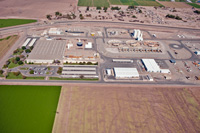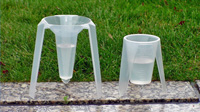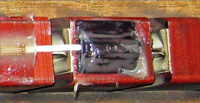- Reclamation
- R&D
- Technology Transfer
- Success Stories
Success Stories
Reclamation has developed some innovative solutions to water and power challenges. Some of our licensing successes are described below. For more information on these and other patents and licenses, please contact the Technology Transfer Staff.
-
Turn Impaired Waters into Useable Waters

The Colorado River is the principal source of water for irrigation and domestic use in Arizona, southern California, and southern Nevada. Ensuring adequate water availability for this region of the country is an ongoing challenge. Reclamation entered into a Cooperative Research And Development Agreement (CRADA) with Metropolitan Water District of Southern California, Southern Nevada Water Authority, and the Central Arizona Water Conservation District to help address this challenge. The CRADA objective is to research best methods and new processes for purifying a variety of impaired source waters so that they can be added to the overall water supply of the Colorado River by using Reclamation's Yuma Desalting Plant in Yuma, Arizona. CRADA partners conducted the research at the Water Quality Improvement Center, which is a Reclamation water treatment research center co-located at the Yuma Desalting Plant.
Most of the testing is complete, and the partners are working on compiling the research results into a final report. The research results would serve to advance the capabilities to purify waters. These results can apply not only along the Colorado River, but at other national and international desalination and water reuse facilities. Members of the project team will deliver presentations about the project at various conferences including: American Membrane Technology Association (AMTA) or American Water Works Association (AWWA) Conference in Glendale, Arizona, the AWWA Annual Conference and Exposition in Dallas, Texas, and the Arizona Water Association Conference in Glendale, Arizona. In addition, information from the project will be used to help in long-term planning related to potential future operations of the Yuma Desalting Plant.
-
Measuring Lawn Watering

Reclamation's Upper Colorado Regional Office in Salt Lake City, Utah has developed inexpensive and easy-to-use catch cups (U.S. Patent No. 6,779,399), an associated one-page pamphlet, and an instructional video to help homeowners and landscape professionals irrigate their lawns correctly and reduce overwatering. Reclamation has a non-exclusive license agreement with Utah State University and has currently sold over 16,000 catch cups to irrigation professionals throughout the U.S. and has improved irrigation efficiency, which results in lower water bills, improved landscape health, reduced water pollution, and reduced fertilizer use.
The catch cups measure the amount of water collected across an irrigated area (see sidebar photo). Water measurements are used to evaluate sprinkler performance so that sprinkler systems may be adjusted to apply the optimal amount of water. Along with the catch cups, the watering guide and video can be used by the homeowners to irrigate their lawns correctly and reduce over watering. Reclamation's catch cups are superior to similar products and are easier to use than everyday cans or containers.
-
Flexible Magnetic Flux Probe

Reclamation's Hydropower Technical Services Group has developed and patented an inexpensive, small, flat, flexible magnetic flux probe (PDF, 116 kB) that can detect deteriorating insulation in large-scale spinning electrical generators (U.S. Patent No.6,466,009). Reclamation has a non-exclusive license agreement with Iris Power LP, and currently over 150 probes have been sold in the U.S. at a sale price of $1,000 per unit. These units have improved generator reliability and reduced maintenance costs.
The probe consists of a thin, flexible pickup coil on the back side with an electrostatic shield on the front side. The pickup coil, which is used to measure the magnetic flux, is composed of printed circuit board traces etched onto a flexible substrate. The flexible substrate is very light and thin, allowing easy installation into the air gap. If the probe ever happened to come loose during generator operation, the flexible substrate would not damage the generator. This probe provides for consistent and uniform electrical and magnetic characteristics, thus eliminating the need for calibration.
-
Chlorine-Resistant Polyamide Membrane

Reverse osmosis polyamide membranes are used to desalinate and purify seawater, wastewater, and surface water. Chlorine helps prevent biofouling, but rapidly degrades polyamide membranes. Reclamation, Separations Systems Technologies, and University of Denver researchers have collaboratively developed a new group of chlorine-resistant polymers to create chlorine-resistant membranes (PDF, 1.8 MB). This new polyamide membrane chemical formulation increases the life of the membrane and can lower replacement costs. This new membrane can be made in existing manufacturing facilities and can be a drop-in replacement for existing membranes.
Several of the prototypes tested indicated superior chlorine resistance and transport properties equal to or better than traditional polyamide membranes. Reclamation upscaled and manufactured the new membrane and is now conducting long-term testing at several pilot water treatment facilities. Through the facilitation by TechComm, Reclamation has entered into a Materials Transfer Agreement with Dow Chemical Company to evaluate performance of the membrane (U.S. Patent No. 7,806,275).
-
Cellulose Acetate Membrane

Reverse osmosis polyamide membranes are used to desalinate and purify seawater, wastewater, and surface water. Chlorine helps prevent biofouling, but rapidly degrades polyamide membranes. Reclamation, Separations Systems Technologies, and University of Denver researchers have collaboratively developed a new group of chlorine-resistant polymers to create chlorine-resistant membranes (PDF, 1.8 MB). This new polyamide membrane chemical formulation increases the life of the membrane and can lower replacement costs. This new membrane can be made in existing manufacturing facilities and can be a drop-in replacement for existing membranes.
Several of the prototypes tested indicated superior chlorine resistance and transport properties equal to or better than traditional polyamide membranes. Reclamation upscaled and manufactured the new membrane and is now conducting long-term testing at several pilot water treatment facilities. Through the facilitation by TechComm, Reclamation has entered into a Materials Transfer Agreement with Dow Chemical Company to evaluate performance of the membrane (U.S. Patent No. 7,806,275).
-
Controlling Invasive Quagga and Zebra Mussels

Invasive quagga and zebra mussels have the potential to impair or interrupt water and hydropower deliveries as well as create long-term ecological impacts. Mussels can attach to virtually all submerged surfaces and clog water intakes, piping, cooling water systems, and fire protection systems. This impacts related instrumentation and equipment. Reclamation is engaged in a number of research and development activities to address mussel-related issues and impacts. One such effort involves developing, through a CRADA with Marrone Bio Innovations, Inc. (MBI), a promising new treatment product called Zequanox™ (PDF, 72 kB). Reclamation's Research and Development Office is evaluating the efficacy of Zequanox™ at Reclamation's Davis Dam in collaboration with Lower Colorado Region Dams Office and Technical Service Center. Zequanox™ is derived from the dead form of a naturally occurring bacteria, Pseudomonas fluorescens, which has been shown to selectively kill invasive mussels. The bacteria were discovered and patented by New York State Museum with whom MBI has a license agreement to mature and commercialize the technology. If successfully commercialized, this product may have the potential to provide an environmentally preferred alternative to conventional chemicals (such as chlorine) for the control of mussels at hydropower facilities.
Zequanox™ has now been approved by the Environmental Protection Agency (EPA) for commercial use.
Marrone funded Reclamation to help test multiple formulations of Zequanox™ in closed water systems at Davis Dam to fine-tune delivery systems and application rates. Tests on a generator units in June, September, and November of 2011, with results closely monitored. The tests showed the potential for high mussel mortality at proper concentrations. Repeated treatments are expected to be necessary to clear out an infested system and then keep it free of mussels.

